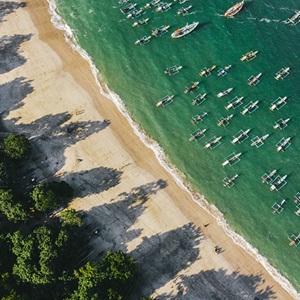When you choose products with the MSC blue label, you're choosing wild caught seafood that has come from an independently verified, certified sustainable fishery.
You don’t need a PhD or seafood guide to choose sustainable seafood. Just look for the blue fish label.
We meet international best practice guidelines and industry standards to ensure that you can trust seafood with the blue MSC label. Studies* consistently find the MSC label to be among the most trustworthy and widely available indicator of sustainable seafood.
Other seafood labels provide different types of information.
Wild and sustainable
The MSC program considers the environmental sustainability of wild capture fisheries. Other schemes, such as that run by the Aquaculture Stewardship Council (ASC) consider aquaculture practices involved
in responsible fish farming. We work closely with the ASC to offer buyers assurances for both wild and farmed seafood. There are some products, containing both wild and farmed fish, where you can find our labels side by side.
There are
also other programs, such as Seafish’s Responsible Fishing Scheme and Fair Trade USA which focus
on the social impacts of fishing such as labour conditions, working hours, and the treatment of crew members. While the MSC is looking to develop enhanced requirements for labour practices, our focus will remain on environmental sustainability.
The big picture
The MSC’s standard for sustainable fishing takes a whole ecosystem approach. Fisheries are assessed according to the sustainability of the fish stocks they target; their impacts on the wider marine environment including habitats and other species;
and how effectively they’re managed.
Other programs may consider just one or some of these elements. For example, dolphin safe labelling focuses on the single issue of interactions with dolphins, defined by the fishing techniques
used, but doesn’t consider impacts on other species or the wider environment.
Fishery focused
Assessment to the MSC Fisheries Standard considers the specific impacts and contexts of a particular fishery. A fishery is assessed on its specific impacts to
determine whether or not it meets the MSC’s requirements.
This differs from seafood recommendations or ratings, such as those produced by WWF,
Monterey Bay Aquarium’s Seafood Watch, Vancouver Aquarium’s Ocean Wise or the Marine Conservation Society. These recommendations tend to focus on species types in general and provide information for consumers or caterers to use in making informed choices. Many take MSC certification into account, but they
use different criteria to determine the sustainability of the fishery, usually based on their own review of information available.
When it comes to the MSC program, all you need to do is look for the blue MSC label on seafood products to
know that a fishery has been assessed as sustainable by an independent auditor.
Truly global
The MSC's blue fish label is found on more than 25,000 seafood products all over the world, with around 300 fisheries certified globally from Iceland to Argentina. This makes the MSC label the most widely used and recognised label for certified sustainable seafood.
In-depth assessment
Assessments to the MSC Fisheries Standard take around 18 months to complete. They’re conducted by independent conformity assessment bodies (CABs) who employ a team of experts to assess the fishery. This team is required to visit the fishery, consult all relevant stakeholders and consider all available data and information in making a decision as to whether or not the fishery should be certified. Their recommendations are also peer reviewed by independent experts.
Supply chain
In order to process, package and sell seafood with the MSC blue label, supply chain companies must be certified to the MSC Chain of Custody Standard. This ensures that seafood sold with the MSC blue label comes from fisheries that are MSC certified as fishing sustainably.
DNA testing has shown that the mislabelling rate for MSC seafood is less than 1%, much lower than many studies for other seafood products and estimates of global mislabelling rates.
Meeting global best practice
Many environmental certification and ratings schemes do not have a supply chain assurance system and cannot provide the same assurances for their claims as the MSC blue label. We are the only program delivering wild caught seafood from practices that simultaneously meets best practice requirements set by the UN’s Food and Agriculture Organization, Global Sustainable Seafood Initiative (GSSI) and the verification body for sustainability standards, ISEAL.
Sustainable seafood from ocean to plate
*Studies comparing the MSC to other seafood labelling programs
- ThisFish Eco-Rating Guide
- Dutch Independent Institute Mileu Centraal, comparison of 90 ecolabels in the Netherlands (2016)
- Authority without credibility? Competition and conflict between ecolabels in tuna fisheries (Miller & Bush, 2015)
- Seafood Ecolabelling (Gopal and Boopendranath, 2013)
- WWF Report: Comparison of Wild Capture Fisheries Certification Schemes (Accenture Development Partnerships, 2012)
- Private standards and certification in fisheries and aquaculture (UN FAO, 2011)



